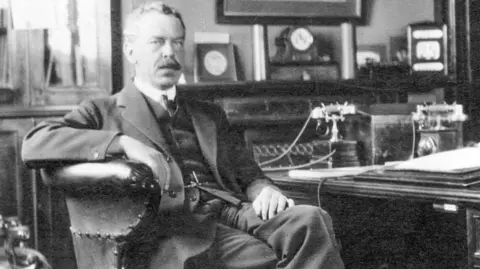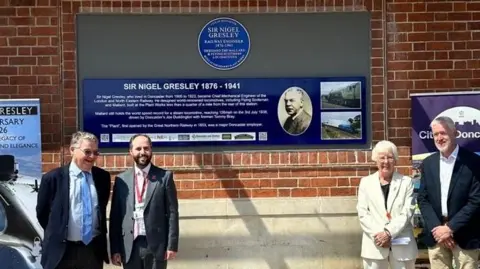Plaque unveiled to honour Flying Scotsman creator
 The Doncaster Grammar School Railway Collection Trust
The Doncaster Grammar School Railway Collection TrustA commemorative plaque has been unveiled to honour the engineer behind some of the world's most famous steam locomotives.
Sir Nigel Gresley designed and built more than 2,000 locomotives, including Flying Scotsman and Mallard.
Ben Godfrey, wo revealed the plaque at Doncaster Station on Thursday, said he was "delighted" to see his grandfather's work recognised.
"His most famous locomotives were built here, so there is a very special family connection to Doncaster," he said.
Born in Edinburgh in 1876, Sir Nigel moved to Doncaster in 1905 to work as a carriage and wagon superintendent and then as a locomotive engineer for Great Northern Railway before moving to London in 1923.
That same year Flying Scotsman was built at the LNER works in Doncaster to Sir Nigel's design and used to pull an express service along the east coast main line between London and Edinburgh.
15 years later another of Sir Nigel's most famous locomotives, Mallard, was built at the Doncaster Locomotive, Carriage and Wagon Works. It still holds the record for the world's fastest steam locomotive after it reached 126mph in 1938.
 City of Doncaster Council
City of Doncaster CouncilMayor Ros Jones said: "Doncaster has a proud connection to the railway industry, and this is another splendid acknowledgment to a man who gave so much to our city.
"It will be a lasting reminder and attraction, to those who live in and visit Doncaster, of his ongoing influence."
Linda Wain, engineering director at LNER, said Mr Gresley's legacy was "deeply woven" into Doncaster and the railway industry.
The plaque and information board at Doncaster Station is close to an existing display which features the names of locomotives built in the nearby workshops.
Sir Nigel died at home unexpectedly in 1941, aged 65, while still working for LNER.
Listen to highlights from South Yorkshire on BBC Sounds, catch up with the latest episode of Look North
